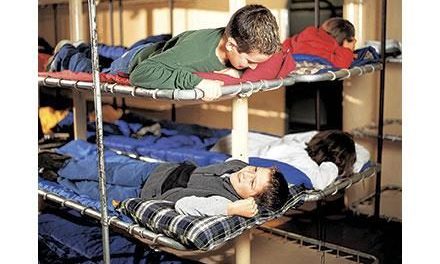Would you feel comfortable saying in front of a gathering of friends that you hate books? Or that you are deathly afraid of reading? The answer for most of us is no. But would you be surprised at all to hear someone say they hate math? Likely not – in fact you may have said it yourself at one time or another. I know I have.
The unfortunate reality is, as a culture (and as parents) we generally perceive language arts as warm and fuzzy, and math as something far less loveable, best left to be taught in school. But thanks to a combination of the rising urgency to improve math education for U.S. students and the work of some creative individuals passionate about making math time just as beloved by children as story time, things are starting to change.
Along Comes Bedtime Math
“We have a culture built around reading for pleasure, but not math for pleasure,” says Laura Bilodeau Overdeck, founder of Bedtime Math, the concept for which she and her husband, John, stumbled upon by giving their children fun math problems at bedtime, just as they would a storybook. When they decided to share their family ritual with a small group of local friends, the list of parents interested in receiving nightly math problems quickly grew, inspiring Overdeck to write, Bedtime Math – A Fun Excuse To Stay Up Late (Feiwel & Friends, imprint of Macmillan, 2013). The book was a huge success and has since started a movement that’s spreading across the nation.
“I immediately saw what an appetite there was for this,” says Overdeck. Along with illustrator Jim Paillot, she set out to break that mold. Bedtime Math combines engaging age-appropriate problems and wildly creative illustrations, such as flamingos and roller coasters, to make math time an activity families can take pleasure in doing together, while at the same time building a math foundation that makes kids better equipped to succeed in school, as well as life.
More than Just Number Problems
Loren Stolow, senior manager of public programs at the Boston Children’s Museum, says she sees Bedtime Math as an insightful way to help families feel more comfortable with math and get past the fear factor. “(It’s about) making it fun and familiar for young children, whether through stories or through games, so they are not turned off,” Stolow notes, adding that math is often right there in front of you just waiting to be played with.
“A lot of math, early and advanced, is about vocabulary and language … it’s already part of the story,” Stolow adds. Books like those by the popular author Eric Carle present fundamental concepts, such as counting, adding and subtracting, identifying what is bigger or smaller, in front of or behind and recognizing patterns. She says parents need to develop a lens to see the lessons these books present. After that they can apply it to just about any aspect of life to find the math, from grocery shopping and cooking to art or sports.
In addition to working on nightly math problems and looking for math concepts in storybooks, families can play card games like Go Fish or UNO, do puzzles and play board games. These activities are not only really easy ways to have a math experience at bedtime, but also great for the simple fact they bring families together for quality time.
Adding in the Modern Math Community
Alex Seriy, instructor at Top Banana Education Foundation, recommends replacing the word math with the idea of playing with numbers. “We (sometimes) forget that play is how children learn,” says Seriy. He suggests families make it part of their routine without over-thinking it.
“Creating the environment where children have to count, or skip count or compare who has more or less helps exercise mathematical thinking and makes it their natural way of looking at things,” says Seriy. Top Banana advocates mental mathematics – math kids can do in their heads – as an efficient and painless ways for kids to learn and become more comfortable with math, and also as a means for more creative and intuitive processing.
“To become successful in mathematics, you have to love it,” says Irina Khavinson, Russian School of Mathematics co-founder and chief education officer. “Games are the most natural way to get very young children seriously and happily engaged in math.”
Co-founder and CEO Inessa Rifkin agrees, adding, “When children have to strategize to find a solution to a problem within a game environment, they are developing problem-solving skills without even realizing it.” Both Khavinson and Rifkin say parents can stimulate critical thinking by making a game out of everyday activities and conversations, from walking to school and driving in the car to shopping or cooking dinner.
It can also be healthy for families to match their math time with whatever they are passionate about doing together. Whether you are working on a do-it-yourself project, baking cookies or making art, things like measuring, weighing and counting typically apply. Seriy says concepts like these are most effective when they’re something you do every day. Rather than treat math like a school subject and put the lone focus on academic goals, Seriy encourages parents to “keep doing those little things and over a period of time it pays off.”
The Final Equation
As a nonprofit organization, Bedtime Math is currently working toward publishing the anticipated follow-up to its debut book and has developed both a fun pajama party kit and a Summer of Numbers calendar that goes out to thousands of libraries across the country as part of the effort to combat summer slide. “Kids need to feel like math is a regular part in the fun part in their lives, outside of school with their families and friends,” says Overdeck. “If we can provide families with really great things to do outside of school, that’s going to change things.”
While studies are ongoing, there is encouraging anecdotal evidence that activities such as Bedtime Math are paying off, providing children with the vocabulary, experience, confidence and perhaps most importantly, enthusiasm for math concepts that extend beyond the classroom. Many parents who have tried these activities with their kids report that even when they are initially met with skepticism and resistance, in a matter of days it becomes something they look forward to, ask for and want more of.
Perhaps the greatest triumph in all this math re-mixing is when adults are able to overcome their long-carried fears. As parents we are role models and we have greater success when we practice do as I do rather than do as I say. While it is impossible to alter the U.S. cultural perception of mathematics in one fell swoop, embracing the movement in our homes will help us raise a generation who feel a little more cozy with math.
Games that Develop Logical Thinking
Fun games from the Russian School of Mathematics:
Pre-K – 2nd grade
• Play cards or board games that require children to calculate scores.
• Use rulers, scales, stopwatches and measuring cups to compare which is the tallest, heaviest, longest, smallest or fastest.
• Play “21” with your fingers. Two players throw down between one and five fingers, taking turns adding the totals to their overall scores until someone gets the closest to “21” (without going beyond it) to win the game.
3rd – 6th grade
• Kids love large numbers and a reason to celebrate. Have your children calculate when they will be exactly 100 months old or 3,000 days old.
Ask your child to graph the performance of a favorite sports team over the course of a season.
• On a car trip, ask kids to estimate how long it will take to reach your destination.
• Play “Guess My Rule.” The first player states two numbers, and then the second player identifies the relationship between the two numbers and provides two more numbers with the same relationship. For example, if I say 4 and 7, the next person might say 2 and 5.
• Ask your child to use his height, the length of his shadow and the length of a tree’s shadow to figure out how tall the tree is.




















